Looking for the Easter sequence (Ireland text)
-
Hi ll, can anyone help me? I am looking for the Official Icel translation of the Easter season set tot he traditional gregorian melody, preferably in neumes but I will take it in modern if you have it. THanks,
My understanding is that this below is the proper translation which must be sung (in Ireland) so other english translations are of no use T
Thanks
Sequence
Christians, to the Paschal Victim
offer sacrifice and praise.
The sheep are ransomed by the Lamb;
and Christ, the undefiled,
hath sinners to his Father reconciled.
Death with life contended:
combat strangely ended!
Life’s own Champion, slain,
yet lives to reign.
Tell us, Mary:
say what thou didst see
upon the way.
The tomb the Living did enclose;
I saw Christ’s glory as he rose!
The angels there attesting;
shroud with grave-clothes resting.
Christ, my hope, has risen:
he goes before you into Galilee.
That Christ is truly risen
from the dead we know.
Victorious king, thy mercy show!
-
Well, it's not on the official ICEL website, which is a little odd in my opinion.
-
The Sequence in the New Rite is treated like just another hymn. The text given in the Lectionary is only mandatory when the Sequence is read by the Lector.
-
Is that the "official" translation? It isn't the translation in any of the missals or hymnals that I have.
-
.
-
That's the one in most books that have English set to the chant, also, but not the text she's asking for.
-
Not sure what's being asked since the translation given above doesn't fit the Gregorian melody.
The version in By Flowing Waters (#151) is similar to that found in ryand's link above (which matches the translation on the USCCB website), but it's a better translation as far as the musical setting is concerned. And BFW has been approved for liturgical use. -
Maybe it is official for Ireland.
-
It is my understanding that the sequence translations in use in the United States are from The Roman Missal © 1964, National Catholic Welfare Conference, Inc. I've never seen an "ICEL translation" of any of the sequences—the translations in the American Lectionary are from the '64 Roman Missal. OCP made the attached music available freely a while back.

 Victimae Paschali Laudes - Easter Sequence.pdf76KThanked by 1bonniebede
Victimae Paschali Laudes - Easter Sequence.pdf76KThanked by 1bonniebede -
@steve in our girm the option to say the sequence is not spoken, you can sing it or omit it.
-
The text given by bonniebede is as in the Missal for England and Wales. I think I have heard it sung, but it is not in the limited resources I have to hand. Perhaps worth asking their liturgy office
-
What an ugly hodge-podge of words! Surprisingly, with some historic verb forms like 'didst' and 'hath'. Why didn't they just use the Neale translation. Oh, I know why: it isn't ugly or clumsy enough - and, IT can be sung to the historic melody.
-
The Sequence text is not contained in the Missal (at least not in the USA). It is found in the Lectionary hence the various translations. The original chant in Latin appears in the Graduale which has no official English translation. Hymnals use various translations.Thanked by 1bonniebede
-
Thanks all for these answers, yes I had found some of those resources, and as far as I can see the text I have above is the text for ireland anyway.
@ rich, I guess I am looking for this text put to the traditional melody with as little adaptation as possible.
-
Okay heres an attempt. Could someone ho knows it please have a sing through and give me some feedback? Derisory laughter not required, thanks,

 Victimae paschale laudes in english own adaptation Rosemary Swords.pdf191KThanked by 1ClergetKubisz
Victimae paschale laudes in english own adaptation Rosemary Swords.pdf191KThanked by 1ClergetKubisz -
The St. Isaac Jogues Missal has a "literal" translation in it - not for singing to the chant.
My Marian Missal has a translation that could easily be sung to the chant.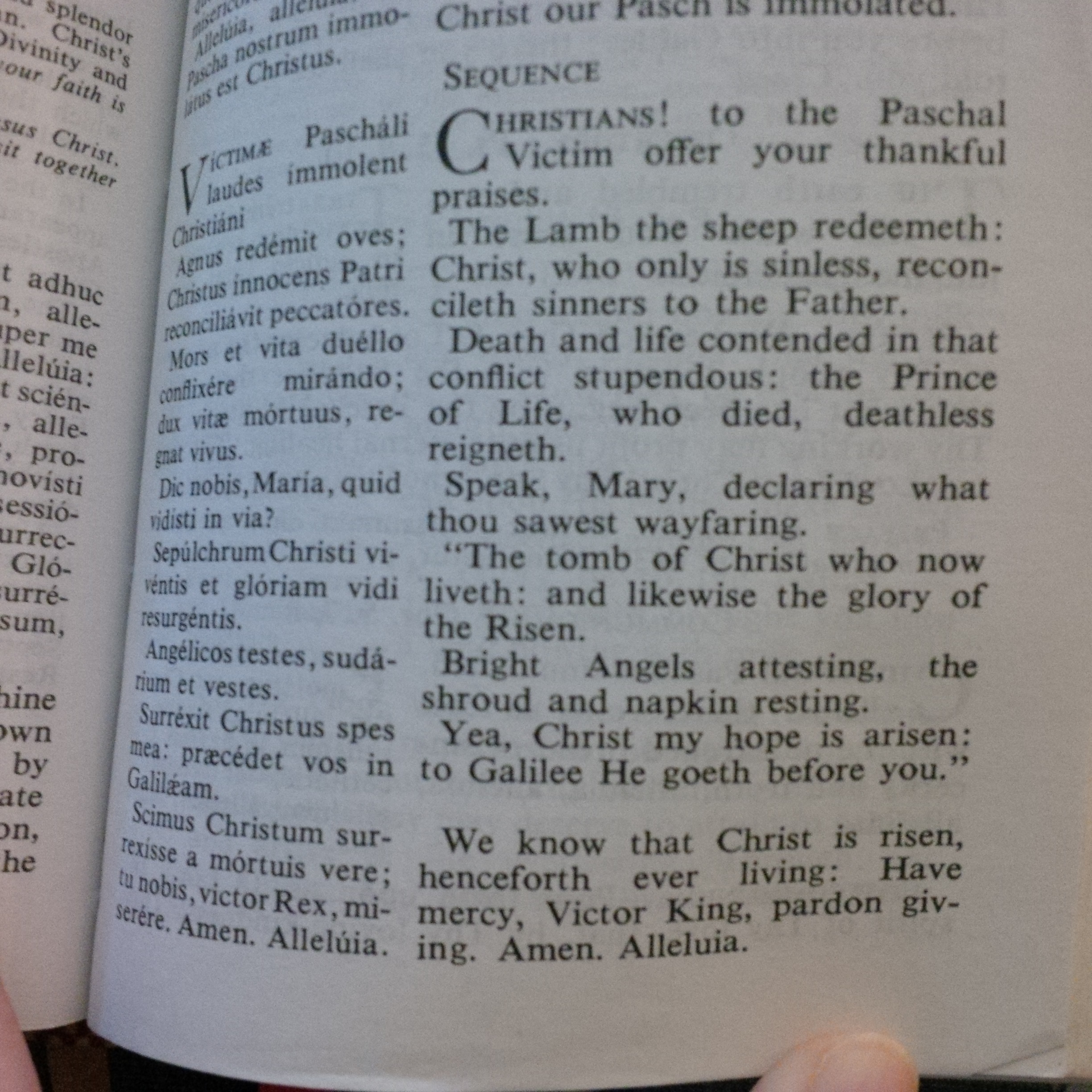
Slightly different from the other popular translation set to the chant.
 IMG_20160316_182540.jpg2448 x 2448 - 1M
IMG_20160316_182540.jpg2448 x 2448 - 1M -
@Bonniebede, I think many of us have already done so.
I'm sure we can all think of ways to "make" your translation fit - but it isn't pretty.Thanked by 1bonniebede -
CCooze's offering from the St Isaac Jogues missal is the Neale translation, except for several words in the last verse. And, it can be sung very well to the historic melody.
Bonniebede - very clever shoehorning! As I 'sang' your solution I was indeed filled with 'derisory laughter' and reminded of Cinderella's sisters trying to fit into her glass slipper. Isn't it a crime what officialdom can pawn off on us to sing (or to make it impossible to sing)!?Thanked by 1bonniebede -
Bonniebede, if you made that score with Gregorio, would you post the gabc here? I'd like to offer a couple of adjustments.
-
(The pictured translation isn't from the St. Isaac Jogues, but from my 1956 New Marian Missal.)
Actually the St. Isaac Jogues "literal" translation (also the translation in the St. Edmund Campion missal (no surprise that they match)) isn't super singable:
"To the Paschal Victim, let Christians offer the sacrifice of praise.
The Lamb hath redeemed the sheep;
Christ the Sinless One hath reconciled sinners to His Father.
Death and Life contended in a wondrous encounter:
the Prince of Life died indeed, but now reigns living.
Tell us, Mary, what sawest thou on the way?
I saw the sepulcher of the living Christ, I saw the glory of Him that had risen.
I saw the angelic witnesses, the napkin and the linen cloths.
Christ, my hope, hath risen: He shall go before you into Galilee.
We know in truth that Christ hath risen from the dead:
Thou, O victorious King, have mercy on us. Amen. Alleluia."
Anyway, I'd just like to say that "I saw Christ’s glory as he rose," sounds an awful lot like they're trying to say that she actually saw Him rise. Which isn't a correct translation or in the Bible, and so isn't a proper bit of text to be singing.Thanked by 1bonniebede -
I'm not sure that there is an ICEL official translation; isn't the sequence in the Lectionary rather than the Roman Missal?
Thanked by 1bonniebede -
I am so glad that we have to sing it in Latin all week!
-
Thanks Chonak.
I am working on two presumptions - a) I should sing the text from the approved lectionary (which is as above in my post) and b) this is the text which will be printed in the missalette for people to follow.
Heres the GABC

 sequence--victimae_paschali--vatican.docx15K
sequence--victimae_paschali--vatican.docx15K -
The Sequence is not treated as a hymn: "hymns" only appear in the Mass as "other chant[s].. suited to the action", as para. 48 of the GIRM.
The Sequence in the New Rite is treated as part of the Acclamation Before The Gospel, GIRM 62-64. Those texts are always "taken from the Lectionary.. or the Graduale", and in general texts taken from the Lectionary are not freely to be substituted or retranslated.
The Sequence does not appear in the novus Roman Missal. -
The Sequence is not treated as a hymn:
But some books describe it as a type of Hymn so causing confusion. -
Just a draft here, moving the existing notes around:
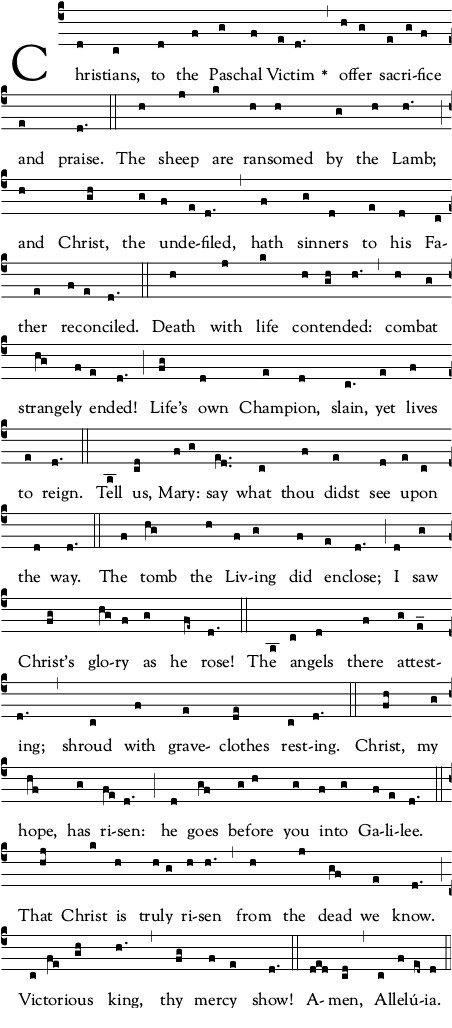
%%
(c4) Christ(d)ians, (c) to (d) the (f) Pasch(g)al (f)Vic(e)tim(d.) *(,) off(h)er(g) sac(e)ri(g)fice(f) and (e) praise.(d.) (::)
The (h) sheep (j) are(k) ran(h)somed (h) by (g) the (h) Lamb;(h.) (;)
and (h) Christ, (gh) the (g) un(f)de(e)filed,(d.) (,)
hath (f) sin(g)ners (d) to (e) his (d) Fa(c)ther (e) re(f)con(e)ciled.(d.) (::)Death (h) with (j) life (k) con(h)ten(gh)ded:(h.) (,)
com(h)bat (g) strange(hg)ly(f) end(e)ed!(d.) (;)
Life’s (fg) own (d) Cham(e)pion, (d) slain,(c.) yet (e) lives (f) to (e) reign.(d.) (::) Tell (a) us,(cd) Ma(f)ry:(g) say(ed..) what (c) thou (f) didst (e) see (d) up(e)on (c) the(d) way.(d.) (::)The (f) tomb (hg) the (h) Liv(f)ing (g) did (f) en(e)close;(d.) (;) I (d) saw (g) Christ’s (fg) glo(hg)ry (f) as (g) he (fe~) rose!(d.) (::) The (a) an(c)gels (d) there (f) at(g)test(e_)ing;(d.) (,)shroud (c) with (f) grave-(e) clothes (de) rest(c)ing.(d.) (::) Christ, (fh) my (g) hope, (hf) has (g) ri(fe)sen: (d.) (;) he (d) goes (gf) be(g)fore (h) you (g) in(f)to (g) Ga(f)li(e)lee.(d.) (::) That(hj) Christ(k) is (h) tru(h)ly(g) ri(h)sen(h.) (,)from (h) the (j) dead(gf) we (e) know.(d.) (;)
Vic(c)tor(fe)ious (gh) king, (h.) (,)thy(fg) mer(f)cy (e) show!(d.) (::) A(ded)men,(cd) (,) Al(c)le(f)lú(ed~)ia.(d) (::)
 sequence.jpg452 x 1028 - 107K
sequence.jpg452 x 1028 - 107K -
The 2007 USCCB document, Sing to the Lord: Music in Divine Worship, states the following about the Sequence at paragraph 166:
Just FYI, of course!The text from the Lectionary for Mass may be used, or a metrical paraphrase may be sung, provided that it is found in an approved collection of liturgical songs. -
Also, I think what was meant is that it's treated like a hymn in the choice of text and music as per Fr. Chepponis's quotation.
-
The 2007 USCCB document, Sing to the Lord: Music in Divine Worship, states the following about the Sequence at paragraph 166:below is the proper translation which must be sung (in Ireland) so other english translations are of no use
Thankfully Sing to the Lord has nothing to do with me, or the question at hand. -
second draft:
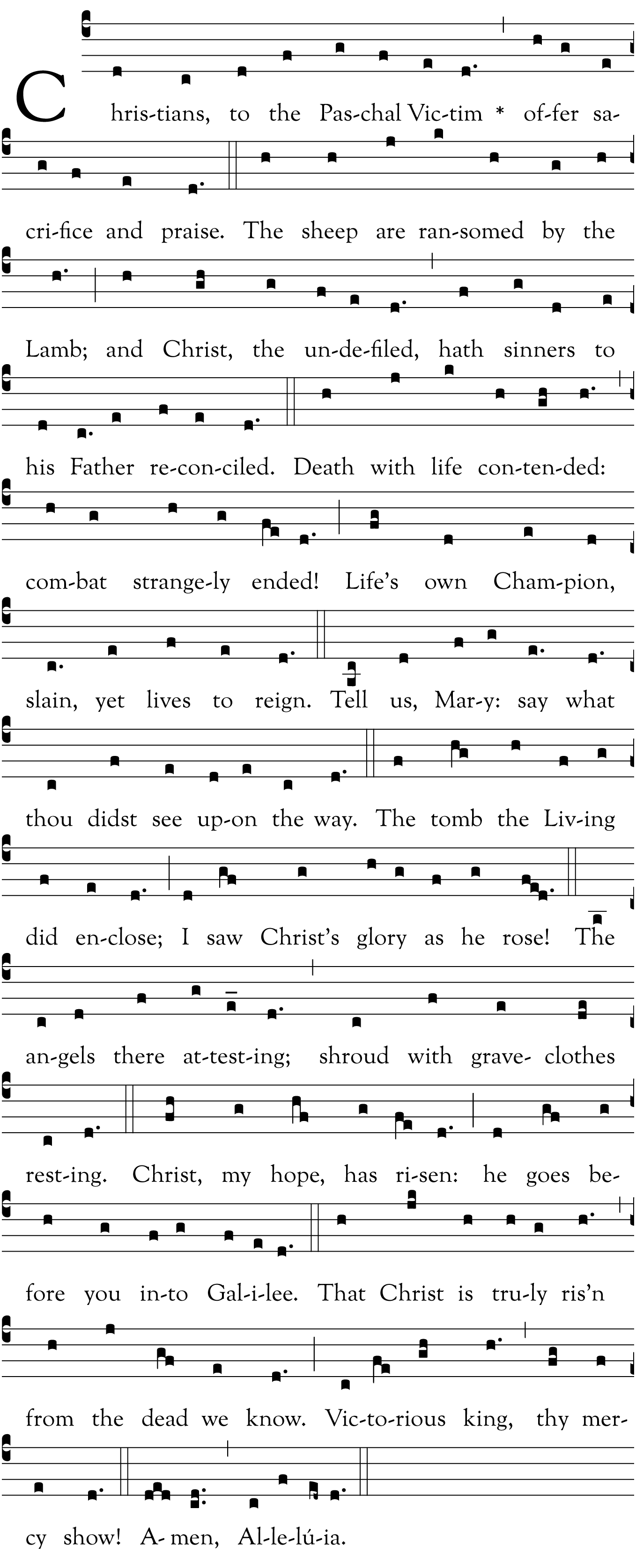
%%
(c4) Chris-(d)tians, (c) to (d) the (f) Pas-(g)chal (f)Vic-(e)tim(d.) *(,) of-(h)fer(g) sa-(e)cri-(g)fice(f) and (e) praise.(d.) (::)
The (h) sheep (h) are(j) ran-(k)somed (h) by (g) the (h) Lamb;(h.) (;)
and (h) Christ, (gh) the (g) un-(f)de-(e)filed,(d.) (,)
hath (f) sin(g)ners (d) to (e) his (d) Fa(c.)ther (e) re-(f)con-(e)ciled.(d.) (::)Death (h) with (j) life (k) con-(h)ten-(gh)ded:(h.) (,)
com-(h)bat (g) strange-(h)ly(g) end(fe)ed!(d.) (;)
Life’s (fg) own (d) Cham-(e)pion, (d) slain,(c.) yet (e) lives (f) to (e) reign.(d.) (::) Tell (ac) us,(d) Mar-(f)y:(g) say(e.) what (d.) thou (c) didst (f) see (e) up-(d)on (e) the(c) way.(d.) (::)The (f) tomb (hg) the (h) Liv-(f)ing (g) did (f) en-(e)close;(d.) (;) I (d) saw (gf) Christ’s (g) glo(h)ry (g) as (f) he (g) rose!(fed.) (::) The (a) an-(c)gels (d) there (f) at-(g)test-(e_)ing;(d.) (,)shroud (c) with (f) grave-(e) clothes (de) rest-(c)ing.(d.) (::) Christ, (fh) my (g) hope, (hf) has (g) ri(fe)sen: (d.) (;) he (d) goes (gf) be-(g)fore (h) you (g) in-(f)to (g) Gal-(f)i-(e)lee.(d.) (::) That(h) Christ(jk) is (h) tru-(h)ly(g) ris-(h)en(h.) (,)from (h) the (j) dead(gf) we (e) know.(d.) (;)
Vic-(c)to-(fe)rious (gh) king, (h.) (,)thy(fg) mer(f)cy (e) show!(d.) (::) A(ded)men,(cd..) (,) Al-(c)le-(f)lú-(ed~)ia.(d.) (::)
[oh, just realized about the extra syllable on "risen" (third line from the end), so it's fixed in the gabc, but not in the pdf]
 VictimaePaschali_IrishEnglish.png1358 x 3350 - 131KThanked by 1bonniebede
VictimaePaschali_IrishEnglish.png1358 x 3350 - 131KThanked by 1bonniebede -
That two-note neume on "Tell" does not sound pleasant.
-
I like two notes on "tell" because it's a verb.
But the phrase could also be altered so that the two-notes fall on "Ma" of Mary, instead: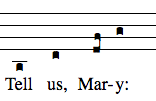
 MaryNeum.png156 x 101 - 4KThanked by 1bonniebede
MaryNeum.png156 x 101 - 4KThanked by 1bonniebede -
Here's what doesn't come out right, in my opinion.
The Latin chant for that line has a musical accent every two beats, independent of the word accents; and you may have considered this already:
Dic no-bis Ma-ri-a...
If we preserve those accents and use the version above (two notes on "tell"), we get:
Te-ell us, Ma-ry, say...
If we adopt the version with two notes on "Ma-", the line falls this way:
Tell us, Ma-a-ry, say...
...both of which are awkward. So we're compelled to move the musical accents in verse 4; but then when the melody returns in verse 6 ("The angels there..."/"Angelicos..."), the accents don't need to be moved, so it'll be inconsistent.Thanked by 1bonniebede -
It's bad enough to start with.
The more it's tinkered with the worse it gets.
Thanked by 1Richard Mix -
This just proves, once again, that translations that are meant to be spoken by the Lector at the ambo are NOT appropriate to be set to music. Parts of the Mass to be sung or chanted should NOT be restricted to the translation in the Lectionary to be spoken.
-
trying to set Gregorian melodies to English is putting square peg in round hole. rewrite the melody to fit the English entirely or just sing the Latin. English chant is totally substandard to the GC.
it's like, "let's paint this Van Gogh with crayons. I know we can do it! get real people. just use your time and effort to admire the real thing. why do you feel you must change what is already perfect in its own way? -
It is not impossible, but it is hard. But I would rather have Latin anyways...Thanked by 1francis
-
Folks...the ICET one is fine...except for their very obvious avoiding of archaic/elevated language.
-
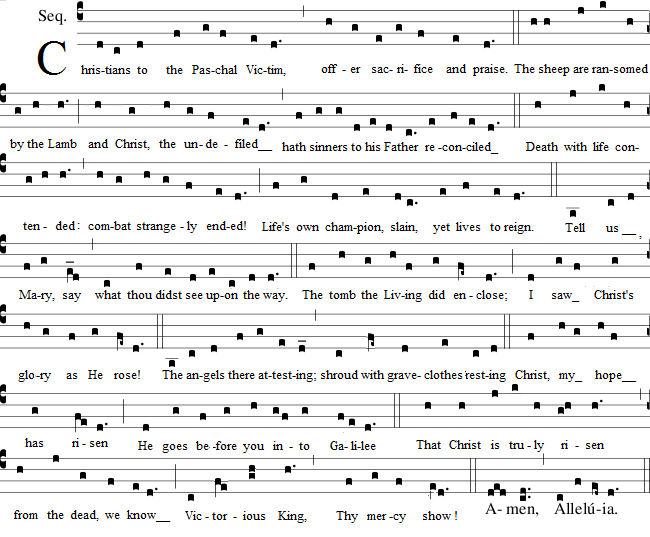
(I realize that I didn't change all the neums, but that's because I was going off of a Latin chant page to make sure everything stayed as should be.)
 VPL - trans.png650 x 537 - 34K
VPL - trans.png650 x 537 - 34K -
The best version of this Sequence I have ever heard was done by Dennis Fitzpatrick. (Yes, THE infamous Dennis Fitzpatrick, who was the head of FEL, "Friends of the English Liturgy".) He did a masterful job, changing the wording of the Sequence to make a great fit of the verbal and musical accents. He seemed to have a gift for this. It is done beautifully.
-
I suppose that it would be possible for some benighted soul to author a Latin version that was as awful as the English version under discussion here. And, very likely, it has been done here and there. It is really unfair to compare a horrid English version of anything with a fine Latin version of the same thing. Doing so is disingenuous, if not facetious, and betrays nothing more noble than ignorant bias. One might notice that the person responsible for the English version we are discussing is, obviously, no more literate in English than he or she is in Latin. Greater fair play from a more intelligent mind would compare the likes of J.M. Neale with the Latin. Don't we all know that the English translations of Latin that find their way into Catholic liturgical books are, most of the time, thoughtless and un-musical drivel? They are certainly no objective measure of liturgical English at its very best - for which one needs to consult The English Hymnal, or Divine Worship: The Missal, and its progenitors.
I have always loved Latin. But these persons who seem almost to believe that God only understands Latin, and that Latin is holier than English give me second thoughts. Um, don't they realise that God really prefers Cranmerian English?Thanked by 1CHGiffen -
Thanks to all who showed their thinking in adapting, it is a real education.
-
There are plenty of older missal translations that are/were fine.
Why can't people continue use of the sequences and antiphons in Latin, and let others read the translation in their missals (especially if they aren't being "invited" or encouraged to sing, anyway, which would require giving them music), rather than trying to set other languages to the same music? People can handle Latin. And no matter how many times I've heard "but they don't speak real Spanish," the Hispanic communities still pick up and figure out the Latin more easily than many if not most.
Incidentally, I don't see why people insist that "Gloria, Laus et honor tibi sit" means "Glory, Laud, and Honor, and Praise be to you/thee."
Why does "laus" always = "laud and praise"? If they have to have an English setting, why not just "Glory and honor and praise/laud be to thee"? It fits the chant just fine.Thanked by 1tomjaw -
I have always loved Latin. But these persons who seem almost to believe that God only understands Latin, and that Latin is holier than English give me second thoughts. Um, don't they realise that God really prefers Cranmerian English?
Actually, He speaks Hebrew. ;-) -
...Hebrew. [???]
Are you sure, Charles?
I had thought maybe it was Old Church Slavonic. -
I think Hebrew is much, much older.
-
Not as old as Sumerian.

 220px-Meister_der_Weltenchronik_001.jpg220 x 335 - 22K
220px-Meister_der_Weltenchronik_001.jpg220 x 335 - 22K -
Thanks for all the help. Sang it. It went well. Another bit of liturgy somewhat restored. Hurrah.Thanked by 1CHGiffen
Welcome to the MusicaSacra Forum!
To participate in the discussions on Catholic church music, sign in or register as a forum member, The forum is a project of the Church Music Association of America.
Categories
- All Discussions21,079
- General Music Discussion8,207
- Job Openings195
- Management of Music Programs850
- Choral Matters532
- Church Documents and Rubrics524
- CMAA Notes300
- Events715
- For Newcomers: Read First26
- Sacred Polyphony546
- Hymnody871
- Gregorian Chant: General2,694
- ↳ Graduale Romanum and Liber Usualis367
- ↳ Graduale Simplex60
- ↳ Semiology63
- Vernacular Plainsong696
- Anglican Use and Anglican Chant68
- Organ, Other Instruments and Repertoire434
- New Composition/Works in Progress1,288
- Recordings230
- Music for Hispanic Ministry159
- Music Education: Children211
- Music Education: General222
- News Items245
- Positions Wanted2
- General Discussion: Catholicism738
- Amusements176
- General Discussion1,033
- Opinions117







